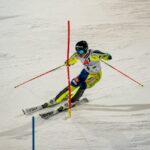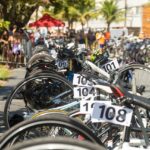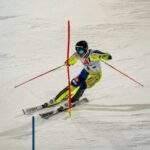The 2023-24 alpine race season is now underway. From St. Moritz to Copper to Edouard to many other race venues in between and beyond, it’s “go time” for racers from juniors up to the World Cup. So, now is the time to shift from training mode to race mode.
the time to shift from training mode to race mode.
This transition requires several important changes in your focus and in how you approach your training:
- From focus on technique and tactics to focus on going fast.
- From details of skiing to big picture of skiing.
- From thinking and analyzing to feeling and trusting.
- From lower intensity to race intensity.
- From training preparation to race-like preparation for training runs.
Good Skiing vs. Fast Skiing
This difference between good skiing and fast skiing is a huge distinction for me and one that I work with racers on constantly. Over my many years in ski racing, first as a racer and then as a mental coach, I have seen many good skiers. They were technically and tactically sound and made really nice turns. These good skiers were solid and consistent. Only one problem. They weren’t usually on the podium. Why? Because they were more focused on skiing well than skiing fast.
 Here’s the problem. Good skiing doesn’t necessarily translate into fast skiing. I’m on the hill with young racers constantly each winter and summer and I see a misguided emphasis on good skiing among both racers and coaches. Of course, solid technique and tactics are necessary to ski fast, but they are not sufficient. And the last I checked, they don’t give style points in ski racing. All that matters is the time that accumulates between the start and the finish. You can have a beautiful run and be slow, and you can have a truly ugly run and be fast. In fact, thinking back to my racing days, the races in which I thought I had skied great were inevitably slow and the races where I was hanging on for dear life were almost always fast.
Here’s the problem. Good skiing doesn’t necessarily translate into fast skiing. I’m on the hill with young racers constantly each winter and summer and I see a misguided emphasis on good skiing among both racers and coaches. Of course, solid technique and tactics are necessary to ski fast, but they are not sufficient. And the last I checked, they don’t give style points in ski racing. All that matters is the time that accumulates between the start and the finish. You can have a beautiful run and be slow, and you can have a truly ugly run and be fast. In fact, thinking back to my racing days, the races in which I thought I had skied great were inevitably slow and the races where I was hanging on for dear life were almost always fast.
Here’s how I think about good skiing:
- Stable
- Balanced
- In control
- Clean
- Comfortable
- Smooth
- Safe
- NOT FAST!
In contrast, fast skiing is a very different approach to racing. Good skiers focus on going around the gates during a race run. But fast skiers aren’t thinking about going around the gates. The Mikaelas and Marcos of the World Cup are focused only on getting from the start to the finish as fast as they can. Of course, they know they need to go around the gates because those are the rules, but that’s not what’s on their minds.
of the World Cup are focused only on getting from the start to the finish as fast as they can. Of course, they know they need to go around the gates because those are the rules, but that’s not what’s on their minds.
Here’s how I think about fast skiing:
- Unstable
- On the edge
- Ragged
- Risky
- Uncomfortable
- FAST!
It’s important to note that you can’t have fast skiing without good skiing. If you don’t, you’ll be fast for a few gates, but will probably make a huge mistake or blow out because you weren’t skiing well enough to manage the fast skiing start to finish. An essential part of this shift from training mode to race mode is to ensure that you take your good skiing to the next level of skiing fast.
Speed is an Acquired Skill
Just like technique and tactics, I don’t believe speed, that is, going as fast as you can, comes naturally to many racers. Rather, it needs to be practiced and learned. When you first start focusing on skiing fast, you’ll feel out of balance, out of control, and uncomfortable. Your mind and body won’t be able to keep up with the speed and you will likely make mistakes, DNF, or crash at first. You need time (and a lot of reps) to figure out how to stay on top of a new level of speed.
 When you shift to race mode, you do the things you know you need to do to ski fast, for example, before a training run you may increase your intensity, use aggressive breathing, or get yourself fired up to attack the course. You also need to have the perspective that you may make mistakes when you ignite the afterburners and that’s actually a good thing because it means that you’re pushing your limits. When this happens, you need to remind yourself to be patient and stay committed because in time, your mind and body will catch up with the new speed and you’ll not only be faster, but you’ll also finish.
When you shift to race mode, you do the things you know you need to do to ski fast, for example, before a training run you may increase your intensity, use aggressive breathing, or get yourself fired up to attack the course. You also need to have the perspective that you may make mistakes when you ignite the afterburners and that’s actually a good thing because it means that you’re pushing your limits. When this happens, you need to remind yourself to be patient and stay committed because in time, your mind and body will catch up with the new speed and you’ll not only be faster, but you’ll also finish.
Find Your Threshold of Speed
There is only one way to find out how fast you can ski, and that is by crossing the threshold and perhaps crashing and burning. Good skiing doesn’t allow that to happen; only fast skiing does. What makes the great ones great is their ability to find that threshold and then ski just inside of it consistently. Finding and staying just inside that line is a skill that takes practice and the willingness to fail and to get really uncomfortable until that which was uncomfortable becomes comfortable and fast skiing gets faster.
Yes, of course, continue to improve your technique and tactics. But don’t stop there. Once you’re feeling solid in those two areas and doing good skiing, set them aside and turn your attention to what ultimately matters most in our sport—fast skiing!—and let ‘er rip.
Train Like You Race, So You Can Race Like You Train
A key part of this transition from training mode to race mode is to ensure that you train like you race so you can race like you train. Here are several key rules to ski by.
First, whatever you do in races, you must first do in training. This seems obvious yet is often neglected by racers. If you want to ski technically and tactically well in races, you better get that technique and those tactics down in training first. But, with race season upon us, you also need to ingrain the feeling of going fast in your training, so it comes more naturally in races.
Second, whatever you do in training is what you will do in a race. Ideally, the purpose of training is to develop effective skills and habits that will translate into fast skiing on race day. It also means developing the skill of speed. But here’s the problem: racers often practice bad skills and habits in training, whether technical, tactical, mental, or speed.
So, think about what you do on race day to get ready and do the same things in training as part of your training routine. For example, do a good skiing warm-up, inspect the course (don’t just slip it), get your body moving at the start, do mental imagery, grab your focus on going fast. Of course, you’re not going to spend 15-30 minutes getting ready for each training run, but you should take key elements of your race routine and shrink it down to a 1-2 minute training routine.
The more you can make training like a race, the more you will ingrain in your body and mind the skills and habits to ski fast in a race. The ultimate goal of which is that when you get into the starting gate of a race, your body and mind automatically do what you do in training, and you will ski fast in the race just like you do in training.
Mindset
A really important shift you’ll want to make is in your mindset. When I talk about mindset, I mean what you’re thinking 3-5 minutes before you get into the gate. In training mode, your mindset was probably focused mainly technique and tactics. But in race mode, your mindset should change to a focus on what you need to do to just ski fast.
With most racers I work with, this means adopting a more aggressive mindset. Key tools for getting an aggressive mindset include raising your physical intensity, using intense breathing (forced exhale), using aggressive self-talk (“Attack,” “Charge,” “Let’s bring it”), and using aggressive imagery in which you see and feel yourself attacking the course.
Use Mental Imagery
As you probably know from all of my writings about mental imagery, I believe it is a powerful tool to help you achieve your ski racing goals. It is also an essential tool in helping you get into race mode. So much of going fast involves getting a lot of repetition in going fast and getting comfortable with a new level of speed. You can use imagery to accelerate that process.
As you get deeper into race mode, regularly (say, three times a week or more) see and feel yourself just plain skiing fast. For 5-10 minutes in each imagery session, imagine yourself getting ready to ski fast before your training and race runs. Then, see and feel yourself being aggressive, charging down the course, and pushing your limits. With every imagery session, you will more deeply ingrain the image and feeling of skiing fast in your mind and body. So, on race day, those same images and feelings will emerge, put you in “full send” mode, and enable you to ski your fastest.
Exercises
To help you make this shift from training mode to race mode, here are a few exercises you can use in your on-snow training:
- Establish a consistent training routine that is a mini version of your race routine to ensure total “race mode” preparation before every training run.
- Equipment (boots buckled, armor adjusted).
- Physical (move body, breathing).
- Mental (imagery, self-talk).
- Incorporate several “race” runs (i.e., focus on just going fast) into training sessions.
- Make the first two runs of training “race” runs to train mind and body to go fast the first two runs (because that’s what has to happen on race day).
- Do things to ski fast.
- Make a commitment every run to skiing fast.
- Grab an aggressive mindset.
- Raise your physical intensity.
- Do imagery of fast skiing before every training run.
- Do off-snow imagery of aggressive and fast skiing.
- Focus on confidence, aggressiveness, and feeling (not thinking).
- See and feel yourself skiing really fast.






